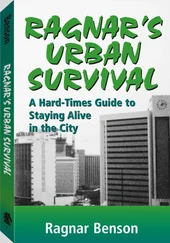Ragnar Benson - Ragnar's Urban Survival - A Hard-Times Guide to Staying Alive in the City
Здесь есть возможность читать онлайн «Ragnar Benson - Ragnar's Urban Survival - A Hard-Times Guide to Staying Alive in the City» весь текст электронной книги совершенно бесплатно (целиком полную версию без сокращений). В некоторых случаях можно слушать аудио, скачать через торрент в формате fb2 и присутствует краткое содержание. Год выпуска: 2009, ISBN: 2009, Жанр: Старинная литература, на английском языке. Описание произведения, (предисловие) а так же отзывы посетителей доступны на портале библиотеки ЛибКат.
- Название:Ragnar's Urban Survival: A Hard-Times Guide to Staying Alive in the City
- Автор:
- Жанр:
- Год:2009
- ISBN:1581600593
- Рейтинг книги:5 / 5. Голосов: 1
-
Избранное:Добавить в избранное
- Отзывы:
-
Ваша оценка:
- 100
- 1
- 2
- 3
- 4
- 5
Ragnar's Urban Survival: A Hard-Times Guide to Staying Alive in the City: краткое содержание, описание и аннотация
Предлагаем к чтению аннотацию, описание, краткое содержание или предисловие (зависит от того, что написал сам автор книги «Ragnar's Urban Survival: A Hard-Times Guide to Staying Alive in the City»). Если вы не нашли необходимую информацию о книге — напишите в комментариях, мы постараемся отыскать её.
Ragnar's Urban Survival: A Hard-Times Guide to Staying Alive in the City — читать онлайн бесплатно полную книгу (весь текст) целиком
Ниже представлен текст книги, разбитый по страницам. Система сохранения места последней прочитанной страницы, позволяет с удобством читать онлайн бесплатно книгу «Ragnar's Urban Survival: A Hard-Times Guide to Staying Alive in the City», без необходимости каждый раз заново искать на чём Вы остановились. Поставьте закладку, и сможете в любой момент перейти на страницу, на которой закончили чтение.
Интервал:
Закладка:
Bean stalks, leaves, hay grass, cornstalks, zucchini rinds, carrot tops, and any other cellulose material can be gathered as feed for rabbits. During spring, summer, and fall they can be fenced into small grassy areas to eat on their own. Summer and fall are also the times when grass and weeds are cut, cured in the sun and then piled for winter food. I also recommend storing a bit of commercial feed against the time when the home-produced kind runs short. Don't try running rabbits out in areas where hungry soldiers, owls, or dogs are likely to find them.
Rabbits are easy, but not really easy to raise. Now and then, especially in the winter, domestic rabbits fail to breed or lose their litters. There's no obvious explanation, the litter is just born dead or quickly weakens and dies. Often it is the doe's fault. I give her two chances and then off to the pot.
Pigeons
Semidomestic pigeons are another kind of livestock city survivors can use to great advantage. Once established, pigeons mostly care for themselves. They need a protected, secluded roosting area more than a pen. Pigeons fly in and out for their own food and water. They pair for life, producing eight pairs of young per year, always setting two eggs. The young weigh almost a pound dressed at maturity in 30 days.
Fifteen pairs of pigeons produce enough young that, at a minimum, city survivors can figure on four pigeons for dinner per week. Theoretically it should be more than that, but things seldom work out perfectly The process of producing young is materially speeded by a biological oddity of pigeons. Males take over the chore of raising the young from about day 26 till first flight, while she starts the next two-egg nest.
On the downside, pigeons are extremely dirty and full of parasites. They reportedly carry virtually every disease and parasite known to man. They are smelly and pigeon whitewash is, of course. not particularly aesthetic. Nevertheless, these critters turn themselves into lots of food. Fifty years ago, raising squabs for market was big business in the United States. Poultry factories have reduced the enterprise to the little we see today
Here is how to start a city survival pigeon enterprise:
Select a high room or attic in a building in the city onto which pigeons can easily fly. An attic loft with a window end that can be opened is ideal. For aesthetic and health reasons, it is best if this pigeon loft is as far from living quarters as possible. Pigeons really smell bad on hot, humid summer evenings and they make a surprising amount of noise. Nail or screw a number of flat boards on which the pigeons can roost and eventually build their own nests. It is best if the roost has a sound roof and enough windows to provide light. Rats prey on pigeons, so be sure to protect the birds from these critters.
Breeding stock is acquired by using small snares or a flashlight and net at night to catch roosting pigeons. Collect 10 or 12 pairs to transfer to your loft. Pigeons reach breeding maturity within 3 to 5 months, but this may take too long, especially if the enterprise is launched after turmoil comes. Catching more pairs now rather than less obviously gets t:-le enterprise off to a speedier start. The breeding life of a pair of pigeons is about 5 years.
New captives must be held till they lose their previous homing instinct (as in homing pigeons) or till you can take this instinct away Tightly coop new pigeons in their new loft. Even though feed can be costly and difficult to find, give them all they will eat for 15 days. At the same time, hang a very powerful permanent magnet over the feed pan not toe far from the eating pigeon's heads. Take the magnet away after 8 days. On day 15, open the roost access window during the night, so the critters can leave first thing in the morning. Usually they return!
Previously wild pigeons kept cooped longer than 15 days start going downhill physically Expect high mortality in these circumstances if they must be kept locked up.
When food and water are abundantly available out in nature for the released birds, pairs will start nesting almost immediately. Summarily eat any singles that show no sign of pairing and nesting. These will be really tough but they make OK soups.
Incubation takes about 18 days. The two eggs hatch surprisingly close together. After hatching, young pigeons seem to double in size weekly At 28-30 days the young reach maximum size and should be butchered before their first flight.
Pigeons are easily roasted, and taste somewhat similar to chicken. Roasting is OK when birds are super abundant but most survivors are best served by spreading the protein around a bit. This entails making these guys into potpies., soups, or stews.
Goats, Chickens, and Ducks
At one time, great numbers of goats seemingly running wild lived a few blocks from downtown Beirut. It seems that they actually belonged to someone: several times a month, the owners crept out to shoot a kid or two for the pot. The goats' utility was that they mostly took care of themselves, eating virtually anything made of plant material. On the other hand, theft from the herd may have been a problem. Whether Americans could handle goats is questionable. I recently tried to find a goat to butcher and eat for a dinner for some African friends. Goat owners I talked to reacted in absolute horror at the thought of someone actually eating one of their pet goats.
I personally have raised many chickens, ducks, and goats within the centers of fairly large cities. In my opinion, they are not sufficiently easy, prolific, or disease-free enough to warrant inclusion in city survival livestock. Chickens and ducks are really tough to get to nest on any reliable year-round schedule. They require huge amounts of often tough-to-provide feed.
Their one element of charm involves the fact that chickens and ducks can be kept alive in a kind of live-storage situation.
STORAGE
Food storage and barter are also valid components of a successful city survival food program. Most city survivors emphasize this component over all others. It is a concern that too many sur vivors will take what presently seems like the quick, easy approach, making food storage their only survival food option. Since we never know with certainty how long any crisis will last, some sort of food replacement strategy will always have to be part of an entire program. Unfortunately storage is not only easy, it leaves a false impression that something has actually been done. The continuing admonition of this book is to start now, even on a very modest scale, to learn how to garden, hunt and gather, and raise edible livestock. We can't simply store huge quantities of food and allow events to overtake us.

Stored food such as these MREs are only part of a survival food program.
Even under ideal conditions, when little or no prior planning is made to begin consuming stored food, stockpiles will gradually start to diminish as they are used a little bit at a time to support foods coming in from the garden, field, rabbit hutch, and pigeon loft.
But how much food do city survivors need to store? The rule of thumb is that humans will require between 1 and 1 1/2 pounds of dehydrated protein, carbohydrates, and calories on a dry-matter basis per day. A second rule of thumb suggests that bland, monotonous foods that survivors in their initial doldrums and boredom are not tempted to sit around and eat should be stored. In other words, you won't be tempted to sit around eating if the groceries are monotonous.
This psychology may preclude use of some more traditional survival foods. Various plans-including army surplus MREs (meals, ready to eat), cases and cases of bully beef, and peas, dried, dehydrated, etc.-have all been put forward as survival food plans. I, too, have some MREs as well as dehydrated food in storage. But these are expensive and of limited value. I still much prefer more basic, common boring commodities, which are cheap, easy, and convenient. There's no need to send across the country when you can get them at the local grocery.
Читать дальшеИнтервал:
Закладка:
Похожие книги на «Ragnar's Urban Survival: A Hard-Times Guide to Staying Alive in the City»
Представляем Вашему вниманию похожие книги на «Ragnar's Urban Survival: A Hard-Times Guide to Staying Alive in the City» списком для выбора. Мы отобрали схожую по названию и смыслу литературу в надежде предоставить читателям больше вариантов отыскать новые, интересные, ещё непрочитанные произведения.
Обсуждение, отзывы о книге «Ragnar's Urban Survival: A Hard-Times Guide to Staying Alive in the City» и просто собственные мнения читателей. Оставьте ваши комментарии, напишите, что Вы думаете о произведении, его смысле или главных героях. Укажите что конкретно понравилось, а что нет, и почему Вы так считаете.











